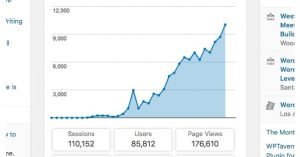How Does Content Marketing Affect Your SEO?
Published by James Parsons • Content Marketing • Posted March 2, 2016 ContentPowered.com
ContentPowered.com
SEO, content marketing, and social media marketing are all parts of the same overall heading of Internet Marketing. They’re all facets of the same gem, and they all work together. If you’re ignoring one of the three, you’re missing out on a lot of potential traffic.
What is SEO? In a narrow definition, SEO is the art of optimizing your website to make it appear higher in the search engine results pages. When a user types in a query, you want them to find your website. To do this, you create pages targeting different keywords, you optimize your headlines, meta titles, and meta descriptions for ideal appearances, you do all sorts of shenanigans with Schema.org, building backlinks and everything else.
What is content marketing? Essentially, it’s all about writing content in a way that you can get it in front of as many people as possible. Sound familiar? You create a blog, you create blog post on a wide variety of subjects. You market this content through various channels, such as organic search, paid advertising, and social media marketing.
Let’s dig into how these two go hand in hand.
The Old Days of SEO
Before 2011, SEO was in something of a “dark age,” though it certainly didn’t seem like it at the time. Thousands of marketers flooded every niche with template websites with very little content, copied and pasted or spun, built up out of nothing. Back then, content didn’t matter. Links were all that mattered, so the sites might not even have relevant text. I have seen sites with completely stolen articles, sites with poorly spun content, sites with content stolen from unrelated sites, and even sites with fragments of books and publications stitched together. It all might as well have been lorem ipsum for all that it mattered.
The purpose of these sites was to build private blog networks, which would number in the thousands or tens of thousands. These massive blog networks would be owned by one person, and people would come to that person for instant search ranking. They would pay a fee, and the network owner would add a link to the target site from each of their private bot-blogs.
The sudden crush of thousands of incoming links would be enough to catapult a site into the top 10 on Google, unless the existing top 10 already did so with a higher volume. It was largely a competition with money.
There was a little more to it than that, of course. PageRank, Google’s link ranking metric, also mattered. Sites with a higher PageRank would have more powerful links. Sites with a lower PageRank would have less valuable links. This is where tiered link building came in. Build 10,000 spam sites and have them all link to a set of 1,000 slightly better sites. Have those 1,000 sites link to 100 higher quality sites, and have them link to 10 actually semi-valuable sites. Those 10 sites would be the sites from which sold links were purchased, and the step by step link tiers would filter PageRank to both insulate the “money” sites and give them more power.
This is all a vast simplification, and it makes the pre-2011 internet sound like a hellish place to be. It wasn’t all bad, but it was made a lot better when 2011 rolled around and Google released the first iteration of the Panda algorithm. To many, this was a godsend, cleaning up the search results and making it easier to rank for high quality sites. To spammers, though, this was the apocalypse. Everything they knew, everything they tried to do, was now actively detrimental.
The problem is, prior to 2011, there wasn’t much emphasis on content. Sure, some pages would have some content, and they might even rank highly with it, but it was easier, cheaper, and faster to rank highly with 100 pages of thin content than with 1 page of high quality content.
The typical FAQ is a good example of this. Prior to 2011, the ideal way to create an FAQ was to create one page with questions, and have every question link out to another page, which contained the answer. The answer pages might only have been 100-300 words long, but that was fine. It was enough to answer the question, if not in detail, and it got some attention. Plus, having 100 question answer pages meant having 100 pages as targets for links, and 100 opportunities to rank in search.
Panda changed everything, along with its sidekick, Penguin. These two algorithm updates completely turned the internet on its head.
The Panda-Penguin Dynasty
Panda and Penguin worked together to destroy all that had come before, and to usher in a new era, ideally a golden age, for internet marketing. Google’s goal behind them was simple; purge the bad and promote the good. People come to Google to find information, and Google wants to do its best to provide that information. They strive to make their search results as good as they possibly can, through a combination of algorithmic sorting and human intervention. If you’re wondering how humans can possibly have a valid opinion, well, they had a set of Google guidelines to follow. Specifically, they had a 160-page PDF of guidelines, which you can view here.
Panda as an algorithm promoted content. The shorter and less valuable the content is on a page, the less of a chance it had to survive in search rankings. Originally, they tended to mean anything under 1,000 words was purged unless it was extremely valuable, and even then it tended to be demoted somewhat. Longer, more valuable content was promoted, getting a higher search ranking on its own and giving its host site a better ranking overall.
Panda also included some semantic and contextual analysis elements. Length was far from the only important metric. If your content was analyzed and determined to be spam, it would be culled and your site penalized. If your content was analyzed and determined to be copied from another source, in whole or in part, it would be culled. If your content didn’t make sense in the context of the rest of your site – for example, a video game review on a site mostly about lawn care – it would be determined to be irrelevant and would be valueless to the rest of your site as a whole.
Think of Panda as the upwards pressure on content, then. Penguin, meanwhile, had a different agenda. Penguin was the link algorithm, and it worked to augment, then supplant, then finally replace PageRank. Penguin analyzes links and determines their source, and the quality of that source. It determines how valuable a link is, and it tended to hit a lot of sites hard. Sites that bought links in the past would generally have to work to remove them to ease the penalties on their site. Penguin put downward pressure on the value of links.
The end result is that, these days, content marketing more or less IS SEO. If you want to rank highly in Google, you need to create high quality content. You need to then market that content to gather together the links and social promotion to push your rank higher and secure it in place.
Modern Internet Marketing
Modern SEO is part of content marketing, which is part of internet marketing, which is part of the overall sales and promotion of a business. It’s all one ongoing process.
In order to be ranked highly in search, you need pages that qualify. Pages that qualify are pages with a lot of high quality content on them. This means a lot of things.
- It needs to be long enough. These days, the ideal length for content tends to be a hair over 2,000 words, though some high quality content stretches for 3,000 or longer. Very rarely do you find high quality pages under 1,000.
- It needs to include multimedia. Every post should have several images, and some may want gifs or even videos embedded to break up the monotony of the text.
- It needs to be well written. Using language that’s readable and not too dense, typing accurately, with no typos or misused words is all crucial.
- It needs to be correct. When discussing opinions it’s okay to be controversial, but where facts are concerned, they need to be accurate. Google can cross-reference and won’t want to promote content that’s obviously wrong.
- It needs to be properly formatted. Headline, subheadings, bullet points, and so forth are all essential elements to a good piece of content. Short paragraphs are generally beneficial as well.
- It needs to provide value. I could write 2,000 words on why many dogs are brown, but that doesn’t provide any value or interesting information to anyone. Good content answers questions and serves a purpose, or instructs someone in a task.
That’s all just the content itself standing on its own two feet. You also have everything the content needs to be in context of the site as a whole.
- It needs to be relevant to your overall topic. If your blog is largely about golf, you’re not going to want to publish content that talks about space exploration, unless you’re talking about it in the context of golf on other planets.
- It needs to be about a topic that you haven’t covered before. This is partially to avoid any potential copied content, but also it helps avoid “keyword cannibalization,” where two posts harm each other in the attempt to be ranked in search for that topic.
- It needs to use keywords that have some decent search volume. If you’re not using keywords that can bring in traffic, there’s very little point in creating the content.
- It needs to have internal links that point to other pages on your site (and other pages need to link to it.) External links are important, but so too are internal links.
- It needs to maintain the same tone, voice, and style as the rest of the work on your site, or at least the rest of the work credited to that author for multi-author sites. Google killed Authorship, but that doesn’t mean they don’t pay attention to authors.
On top of that, you need all of the basic SEO stuff, like meta data, Schema.org data, well-formed code, and a fast-loading site. Mobile compatibility is a must as well.
Then you also have all of the article promotion, or the actual marketing part of content marketing. You have to go around and promote your blog post on various channels, earning links from other blogs and getting comments on the content. You need to post it and share it on social media, to get more people to see it and more people to link to it.
To rank highly in Google search today, you need to bring all of this together into one cohesive whole. You can’t write terrible content and expect it to rank, no matter how optimized it is. You can’t write great content and expect it to rank without promoting it. You can’t post to social media and expect your site to rank without content. They’re all legs of a table, and with only one or two, it can’t stand.
Boosting SEO with Content Marketing
SEO is, in my mind, a method you can use to enhance content marketing. That’s because I look at SEO in a narrow light. I consider SEO to be the technical side of things. Keyword research, meta data, Schema.org interactions, site optimization; it’s all the rifling on the barrel of the content marketing gun. If you want your bullet to fly true, it has to be there, but it’s not the heart of the matter.
The problem is that many marketers today thing “SEO” and “web marketing” are the same thing. They think of SEO as anything you do to your site to get your site ranked in search, and they include content marketing as part of that overall. There’s nothing wrong with that outlook; it just means that some conversations tend to talk past one another.
If you look at SEO as the big picture, and content marketing as one of several moving parts, I can see why you might think of it as the lesser of the two. The fact is, modern content marketing is the foundation upon which all the rest is built.
With that in mind, here’s a few tips for what you can do with content marketing to help boost the ranking of your website.
- Strive to create original, high quality content. A detailed analysis of rank 1 sites on Google indicates that the ideal length for a blog post is between 2,000 and 2,500 words. That much content, packed with value, can create a very good article.
- If you can’t find a unique topic, try to be the best at covering the topic. Identify what other content exists and take value from it all, forging it into your own hybrid. Anything another brand can do, you can do better. Use more sources, look deeper, analyze more, predict the future, or take another route to make your content somehow deeper, broader, or better.
- Try to create plenty of content with long-lived appeal. Content that has evergreen usefulness, content that people keep coming back to time after time, is great. Guides for common processes, ultimate references, and other sorts of content work well here.
- Do your keyword research, but don’t focus overmuch on the keywords themselves. The concept of “keyword density” is a dead idea, and anyone who cares about it is outing themselves as stuck in the past. Use keyword research to guide your topic, don’t rely on it to get you rankings.
- Spread your content around to get links. Post it on social media accounts and other blogs you own. Send it to people who might be interested in using it as a reference.
Kick you content marketing into high gear, boost it with a little SEO grease, and send it running with social media. With all three legs in action, you’re sure to find rankings.









